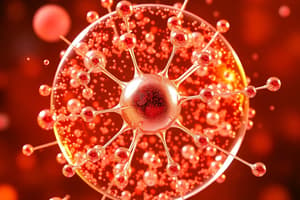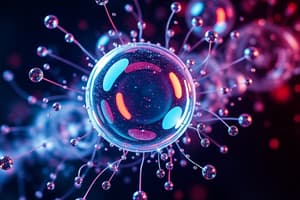Podcast
Questions and Answers
What type of model is the Earth-centered model?
What type of model is the Earth-centered model?
- Geocentric (correct)
- Spiral
- Heliocentric
- Elliptical
What is the maximum sustainable population of a species in an ecosystem?
What is the maximum sustainable population of a species in an ecosystem?
- Bioaccumulation
- Invasive species
- Population growth curve
- Carrying capacity (correct)
What is the characteristic of Mercury in our Solar System?
What is the characteristic of Mercury in our Solar System?
- Farthest from the Sun
- Largest planet
- Closest to the Sun (correct)
- Has the most moons
What is the unit of distance from the Earth to the Sun?
What is the unit of distance from the Earth to the Sun?
Why do meteors glow?
Why do meteors glow?
What is the main characteristic of particles in a solid state?
What is the main characteristic of particles in a solid state?
What is the purpose of grounding in discharging objects?
What is the purpose of grounding in discharging objects?
What is the difference between a series circuit and a parallel circuit?
What is the difference between a series circuit and a parallel circuit?
What is the role of decomposers in an ecosystem?
What is the role of decomposers in an ecosystem?
What is the main difference between a food chain and a food web?
What is the main difference between a food chain and a food web?
Flashcards are hidden until you start studying
Study Notes
States of Matter
- There are three states of matter: solid, liquid, and gas.
- Particle Theory: matter is made up of particles that are always in motion, attract each other, and have space between them.
- Particle movement increases with temperature.
Pure Substances and Mixtures
- Pure Substances: have a fixed composition, examples include marble, distilled water, hydrogen, and silver.
- Mixtures: have varying compositions, examples include soft drinks, brass, wood, vinegar, air, salt and water, soil, and cereal.
Density of Ice and Wood
- Ice and wood have a density less than 1.0 g/mL, which is why they float on water.
Static Electricity
- Static electricity is the buildup of electric charge on an object.
- Law of Attraction and Repulsion: like charges repel, unlike charges attract.
Electric Circuits
- Electric circuit components include conductors, insulators, and switches.
- Circuit Behavior:
- Closed switch: current flows, bulbs light.
- Bulb #2 unscrewed: circuit open, bulbs before it stay lit.
- Bulb #5 unscrewed: circuit open, all bulbs go out.
Series and Parallel Circuits
- Series circuits have one path, while parallel circuits have multiple paths.
- Household wiring uses parallel circuits for safety.
Resistance Calculation
- Resistance (R) can be calculated using the formula R = V/I (ohms).
Sustainable Ecosystems
- A sustainable ecosystem is a self-sustaining community; examples of unsustainable areas include deforested regions.
Abiotic and Biotic Factors
- Abiotic factors are non-living, such as sunlight and temperature.
- Biotic factors are living, such as plants and animals.
Producer, Consumer, Decomposer
- Producers: plants that make their own food.
- Consumers: animals that obtain energy by consuming other organisms.
- Decomposers: bacteria and fungi that break down organic matter.
Biodiversity
- Natural ecosystems generally have more biodiversity than artificial ones.
Food Web vs. Food Chain
- Food Web: interconnected food chains.
- Food Chain: a linear sequence of who eats whom.
Invasive Species
- Non-native species that cause harm to the ecosystem, such as zebra mussels.
Population Growth Curve and Carrying Capacity
- Population growth curve shows changes over time.
- Carrying capacity is the maximum sustainable population.
Bioaccumulation
- The accumulation of toxins in organisms.
Space Exploration
Motion of Stars Models
- Geocentric model: Earth-centered model.
- Heliocentric model: Sun-centered model (accepted today).
Solar System
- The Solar System consists of eight planets: Mercury, Venus, Earth, Mars, Jupiter, Saturn, Uranus, and Neptune.
Terrestrial Planets
- Characteristics of terrestrial planets, such as Mercury: closest to the Sun, no atmosphere.
Meteor Appearance
- Glowing due to friction with the atmosphere.
Galaxy Types
- Spiral galaxies: have arms.
- Elliptical galaxies: oval shape.
- Irregular galaxies: no specific shape.
Astronomical Unit vs. Light-Year
- AU: distance from Earth to the Sun.
- LY: distance light travels in a year.
Studying That Suits You
Use AI to generate personalized quizzes and flashcards to suit your learning preferences.




